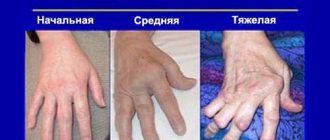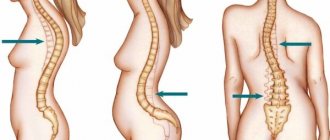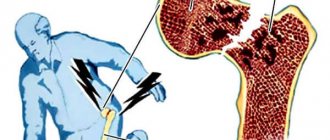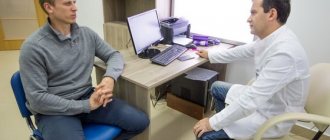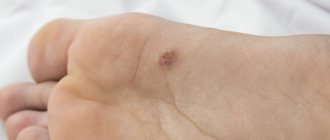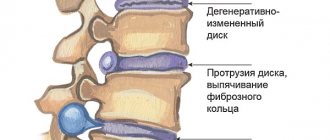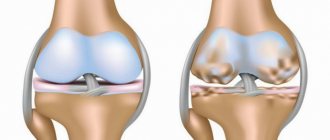Any disease that prevents a person from working and living normally without obstacles and restrictions should be examined by medical and social experts. Employees of the ITU bureau can legally assign any disability group based on the results of medical and social analysis.
There is a certain list of pathologies, and gout is included in it, on the basis of which the patient is assigned the status of a disabled person. But to register a disability, a diagnosis alone is not enough. To understand the nuances of granting disability for gout, in particular, what are the benefits, pension and restrictions in labor relations, you need to carefully study Article 11 of the Federal Law on Pension Security and Government Decree of the Russian Federation No. 95 “On the procedure and conditions for recognizing a person as disabled”, paragraph 5 dated 02/20/2006.
Diagnosis of gout
With gout, there is an increase in the level of uric acid in the blood and an inflammatory process due to the deposition of monosodium urate in the joints and internal organs. The pathology occurs latently, most often it is detected only after 6 years. According to statistics, the disease is usually diagnosed after 40 years in men.
There are several stages in the diagnosis of gout:
- anamnesis (patient interview) – heredity, age, bad habits, predisposing factors;
- assessment of symptoms - inflammation of the joints of the big toes, ankles, elbows and knees, swelling, redness and severe pain, especially at night or early in the morning;
- instrumental studies: ultrasound, computed tomography (layer-by-layer scanning of the joint), radiography, scintigraphy (introduction of radioactive isotopes into the patient’s body and obtaining a two-dimensional image) with technetium pyrophosphate of the affected joints;
- laboratory tests: biochemical and general analysis of urine and blood, examination of the contents of tophi (gouty nodes) and synovial fluid of the joints.
Is there a disability?
Gout is chronic and systemic, which means it cannot be completely eliminated; people with this disease often have a disability. It is given taking into account the stage of severity of the disease:
- The first one does not in any way reduce the patient’s quality of life, since the disease does not manifest itself at all, so a group cannot be obtained at this stage.
- The second one involves certain restrictions on the ability to move independently, provide services and work; the person becomes a disabled person of the third group.
- Third, persistent changes appear in motor activity, work activity, and difficulty in self-care. In accordance with the rules, the patient is a disabled person of the second group.
- Fourth, the manifestations of chronic tophi gout almost exclude the patient’s ability to move independently and solve everyday problems. With such symptoms, he is assigned to the first disability group.
The special commission carefully familiarizes itself with the available medical documents and various types of data on everyday, social, psychological, professional and labor conditions.
Medical and social examination
ITU is a group of citizens that evaluates in a certain order the needs of the person being examined for the need for various types of support and protection, including rehabilitation. Simply put, a medical and social examination assesses a person’s ability to work and his need for financial and social assistance from the state. That is, after an expert analysis of a person’s condition, they must be legally recognized as disabled and the degree of damage to his health must be determined.
Objectives of the examination
The objectives of ITU are to provide conditions for people with disabilities that are close to social standards and norms, accessible to any citizen of the Russian Federation. This protects the constitutional rights of a person with disabilities, which are mandatory at the legislative level.
By decision of the ITU, material compensation (receipt of life support) is assigned to citizens or the issue of its abolition is decided. To do this, carefully study the medical history and general manifestations of gout. The main principle of the organization’s work is not so much support in survival, but rather the development of an individual rehabilitation program for a disabled person. The main goal is to maintain or restore human health.
The main objectives of the examination are to determine:
- reasons and duration of incapacity;
- category “disabled child”;
- 1, 2 or 3 disability groups;
- and development of a personal rehabilitation program;
- percentage of disability (for occupational diseases).
Where is ITU held?
After referral from the attending physician, a medical and social examination is carried out at the place of residence, in some cases in the region of residence. When appealing a decision or if special types of examination of the case are necessary, documents are transferred to the main bureau. In particularly difficult cases or if the patient is dissatisfied with the decision, a repeat ITU examination is carried out at the Federal Center.
MSA can also be carried out at home if the patient, for health reasons, is unable to come to the office.
Legal representatives
This group of citizens includes people who, within the framework of the law, in all situations, advocate for the rights of the incapacitated and those with limited legal capacity. Including minor children, their legal representatives are their parents. But when a disabled child reaches 18 years of age, in order to protect his interests, a power of attorney must be issued.
Required documents
Becoming disabled allows you to obtain benefits and a special pension. But to be able to use them, you need to go through some bureaucratic procedures.
List of required documentation to obtain disability:
- referral to the ITU commission;
- completed application - form 088/у-06;
- outpatient card;
- SNILS;
- passport or birth certificates;
- certificates of disability (for re-commission);
- a copy of the work book, with the obligatory certification of the employer (with a description of the work-related injury, form N - 1, or the conditions and nature of work at the enterprise);
- sometimes a certificate of income;
- characteristics from a university or educational institution (for students);
- extracts from medical institutions, results of diagnostic studies that confirm the presence of gout and provide a picture of the general condition of the body.
It is required to provide not only copies, but also originals of almost all documents.
Commission results
A medical and social examination is carried out by a board of specialists, whose actions are necessarily recorded. At the end, a conclusion is issued in the form of an act. The final result is accepted by voting.
Next, an extract from the report is made and the patient is given a certificate (electronic or paper) confirming the fact that disability has been established. If specialists were unable to make a decision due to the need for additional diagnostics, then a referral to the main or federal level ITU is issued.
Degrees of disease and groups
Passing an examination for gout involves assigning one of three disability groups, namely:
I - is established in the fourth degree of the disease with chronic manifestations of arthritis with frequent exacerbations (every 2-3 months), which occur with hyperthermia, tophi, tremors of the hands, and severe kidney damage. At the same time, people cannot perform functional duties at work and, without outside help, take care of themselves at home and move around, for example, with extensive polyatric lesions of the small bones (scaphoid, sphenoid, talus) of the foot.
II - assigned when 2-3 joints are affected with acute manifestation of symptoms once every 3-4 months, with the formation of small tophi and kidney damage. There are signs of pathology characteristic of the second or third stage. Such people are limited in the ability to move independently, self-service, and can only work in specially created conditions.
III - exacerbation of the disease no more than 1-2 times a year, while 1-2 joints become inflamed, manifestations of changes in the kidneys are noted. Patients can take care of themselves, move slowly, study in general institutions, and work with certain restrictions.
Based on symptomatic signs, uric acid levels and the presence of urates, three degrees of gout are distinguished:
- Premorbid – the onset of pathology, when the patient experiences only hyperuricemia. It is diagnosed only by taking a blood test for biochemistry. Sometimes nonspecific symptoms can be noted: increased sweating, weakness, predisposition to excess weight, itchy skin.
- Interval - the beginning of the formation of salt crystals, acute attacks of gout occur, lasting up to a week. The duration of remission is determined by many factors.
- Chronic - constant exacerbations of the disease occur, salt crystals combine into tophi. There are severe pain, inflammation of nearby tissues, and limited mobility. Urolithiasis develops.
If a person works, a sick leave certificate is issued for a period of about a week during an exacerbation of gout. Treatment consists of taking purines, non-steroidal anti-inflammatory drugs, physical therapy and surgical removal of tophi.
Revision of the commission's results
When a patient does not agree with the decision of the ITU, he can appeal the decision within a month by writing a statement. An application for re-examination is sent to the same organization where the patient, in his opinion, was unjustifiably not given a disability or was assigned the wrong disease group.
The bureau is obliged to send a file with the necessary documents to a federal organization within 30 days from the date of registration, and there a re-examination will be carried out there within no more than a month. If the person is still not satisfied with the result, you can appeal to the main ITU center. The court is the final authority for appeal.
If you receive a disability, depending on the group, it must be extended by a commission:
- 2 times a year - disabled people of group 1;
- Once a year - disabled people of groups 2 and 3;
- once, for the period of issue - disabled children.
A re-examination is necessary not only to confirm a previously determined disability, but also to make adjustments to the rehabilitation program and to track the dynamics of changes in the patient’s general health.
Registration process
You can register a disability by coming for a medical examination and commission, or you can go through it at home if the patient is unable to come. A disability group is established only if there is a confirmed disease included in the list on the basis of which a group can be obtained. But in addition to the above, the presence of two more factors is necessary - a persistent disruption of the functioning of the body, a complete or partial limitation of a person’s life, as well as the need for rehabilitation or social protection of people with disabilities.
If all the conditions are present, you must visit your attending physician, who will refer you to a doctor’s commission. The commission will consider this issue and provide a referral to the ITU Bureau, where a decision will be made on establishing the disability and the group. To visit the ITU office, you must have a passport, a referral from a medical institution in form 188-u and a completed application.
Answers on questions
Which group is assigned for grade 3 chronic gouty arthritis?
The exact answer can be obtained after passing the ITU. But, as a rule, patients with such a diagnosis are given a second disability group.
Do pensioners receive additional payments for disability?
State and insurance pensions are often calculated depending on length of service, length of service and pension savings. Additional payment is made for the first group of disability, for military personnel if the incapacity was acquired during hostilities, for WWII participants and veterans.
How long can the disability registration process take?
The examination must be carried out no later than one month after the submission of the necessary documents. A delay may occur if additional diagnostics are needed. The result of the assignment of incapacity is announced on the day of the examination. It may take a maximum of 70-80 days to register a disability.
How can a bedridden patient obtain disability?
If transportation of the patient is not desirable, and he cannot move independently, the legal representative or the patient himself during the medical appointment may raise the issue of conducting an examination at home. The final decision on where the examination will take place is made by the ITU Bureau.
Conclusion
Registration of disability consists of several stages: collection of necessary documents, consideration of each case in the ITU office, repeated examinations. Carrying out the examination requires strength and patience from the patient and his relatives. But to receive pension payments and benefits, you will still have to go through this paperwork.
Do you or your loved ones have gout? Have you encountered disability registration? What advice can you give based on personal experience? We will be grateful for the exchange of views.
More about some criteria
The “punch” symptom is the presence of osteophytic accumulations. At the same time, the joint space is abnormally narrow. The bone tissue is partially deformed. Characteristic defective formations in the form of a semicircle or round epiphyseal elements.
It is difficult to say whether disability for gout is given to all patients. This process is very complex in every way. A serious and grueling procedure requires a lot of moral strength and financial costs. If certain signs and symptoms are recorded, which are combined in a certain combination, the patient with gout is assigned one or another disability group.
In fact, any disease that prevents a person from leading a normal lifestyle and working at full capacity requires additional diagnostics and enhanced treatment. If a particular pathological condition is classified as incurable, this means that the patient will be in a state of relative discomfort all the time.


